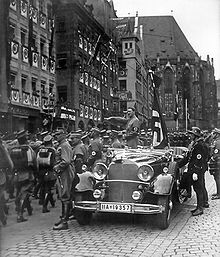Jakob Grimminger
Jakob Grimminger | |
|---|---|
 Adolf Hitler at the SA parade in Nuremberg, September 1935. SA members stand to the left; SS-Sturmbannführer Jakob Grimminger stands behind the car. | |
| Born | 25 April 1892 Augsburg, Bavaria, German Empire |
| Died | 28 January 1969 (aged 76) Munich, West Germany |
| Allegiance | |
| Service/ |
|
| Rank | SS-Standartenführer |
| Battles/wars | |
Jakob Grimminger (25 April 1892 – 28 January 1969[1]) was a member of the Schutzstaffel (SS) known for carrying the Blutfahne, the ceremonial Nazi flag.
Biography
Grimminger was born in Augsburg, Bavaria and entered the Imperial German Army when he was sixteen years old. He served during World War I as a mechanic in an air regiment from 1914 and 1917. He fought in the Gallipoli Campaign. He also served a year in Palestine after which he returned to Germany. Having been awarded the Iron Cross (second class), Bavarian medals and the Turkish Iron Crescent, Grimminger was discharged from the military in 1919.
Grimminger joined the Nazi Party (NSDAP) in 1922 and became a member of the Sturmabteilung (SA). He took part in the fights in Coburg in 1922 and the Munich Beer Hall Putsch of 9 November 1923. After serving in the Brown House, the general headquarters of the NSDAP, he was selected in 1926 to become a member of the Schutzstaffel (SS). Grimminger was promoted many times during his service in the SA and the SS, eventually reaching the rank of SS-Standartenführer (equivalent to colonel). As a member of the SS, he was given the honour of carrying the blood-stained Blutfahne from the Munich putsch. Grimminger was decorated with the Golden Party Badge, the Blood Order (no. 714) and the Coburg Badge, three of the most important decorations of the NSDAP.[1]
Grimminger survived World War II, and was put on trial by the Allies in 1946 for being a member of the SS and carrying the Blutfahne for nineteen years. For this, he was not sent to prison, but all of his property was confiscated. In later life, he reportedly attempted to enter politics and served as a Councillor in Munich; his past, however, prevented him from continuing this career. He died in obscurity in Munich in 1969.
SS ranks by date
- SS-Mann : 25 February 1926
- SS-Scharführer : September 1926
- SS-Truppführer : March 1929
- SS-Sturmführer : 17 July 1931
- SS-Obersturmführer : 31 July 1933
- SS-Hauptsturmführer : 15 November 1933
- SS-Sturmbannführer : 20 April 1935
- SS-Obersturmbannführer : 13 June 1936
- SS-Standartenführer : 20 April 1943
See also
Notes and references
- ^ "Flags of the World". Retrieved December 27, 2005.
- ^ "Internet Movie Database entry on Jakob Grimminger". Retrieved December 27, 2005.
- ^ Dombrowski, Hanns (1940), Orders, Ehrenzeichen und Titel.
- 1892 births
- 1969 deaths
- German military personnel of World War I
- Nazis who served in World War I
- Nazis who participated in the Beer Hall Putsch
- People from Augsburg
- People from the Kingdom of Bavaria
- SS-Standartenführer
- Recipients of the Iron Cross (1914), 2nd class
- Recipients of the Golden Party Badge
- Recipients of the Blood Order
- Luftstreitkräfte personnel
